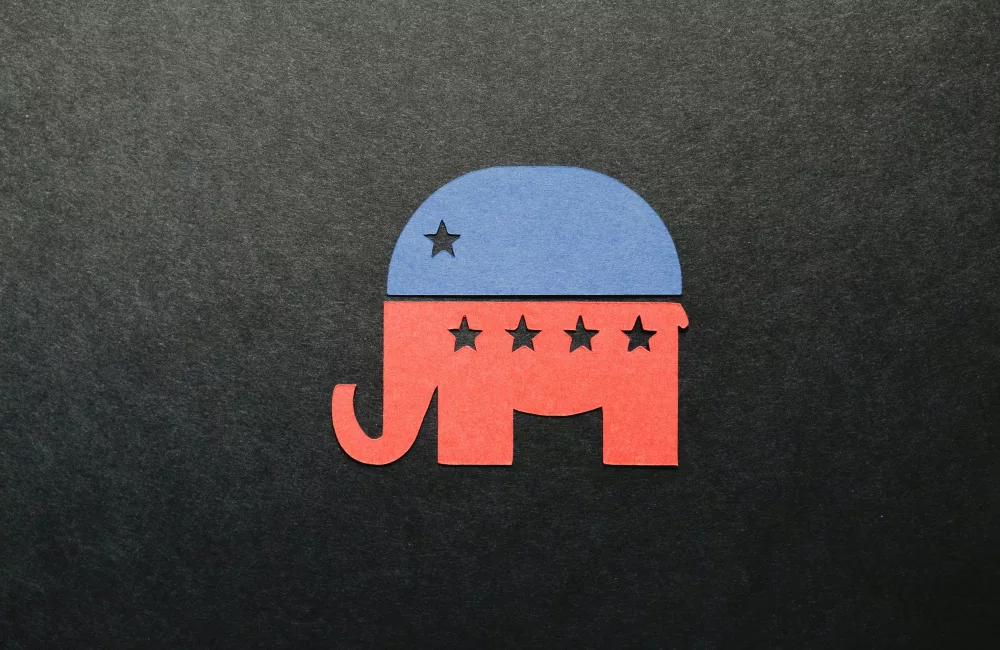Once the party of emancipation and national unity, the Republican Party has undergone a transformation so jarring, it almost defies belief. Today, the GOP finds itself deeply entangled with racial resentment, white grievance politics, and dog-whistle messaging. But how did the party that freed the slaves and fought for the 14th Amendment become a political vehicle for those who chant “America First” and fly Confederate flags? The answer lies in a tangled history of political realignment, strategic manipulation, and a nation that never truly reconciled with its own racial past.
The Republican Party: From Emancipation to Segregation
In its mid-19th century origins, the Republican Party was a radical force for liberation.
Founded in 1854 by anti-slavery activists, the GOP’s core mission was to oppose the expansion of slavery into U.S. territories. This was no minor political squabble. The issue of slavery had already fractured national politics and rendered the existing parties — especially the Whigs — incapable of addressing the moral crisis looming over America.
Enter Abraham Lincoln, the first Republican president, elected in 1860. Under his leadership, the Republican Party became synonymous with emancipation, the preservation of the Union, and constitutional reform. The 13th Amendment abolished slavery. The 14th Amendment granted citizenship to formerly enslaved people. The 15th Amendment protected their right to vote (at least in theory). These were Republican achievements.
At the time, the Democratic Party — particularly its Southern wing — was the party of slaveowners, white supremacy, and later, Jim Crow laws. Democrats in the South fought tooth and nail against Reconstruction, Black suffrage, and federal civil rights enforcement.
So yes — the Republicans were the good guys, and Democrats were the party of racial oppression. That much is historically accurate.
But that’s not the whole story — and certainly not the story today.
The Collapse of Reconstruction and the GOP’s Retreat
The fall of Reconstruction in the late 1870s marked the beginning of a moral and political retreat for the Republican Party.
After Lincoln’s assassination, the struggle to maintain federal protections for Black citizens in the South became politically costly. The rise of white supremacist violence, including the emergence of the Ku Klux Klan, made enforcement dangerous and expensive. Southern resistance was fierce. Northern Republicans, more interested in national unity than racial justice, began to back away.
In 1877, the Compromise that ended Reconstruction saw federal troops withdrawn from the South — effectively abandoning Black Americans to the mercy of the old planter elite. The GOP — once the party of abolition — now stood by as states imposed poll taxes, literacy tests, lynchings, and segregationist regimes.
By the turn of the 20th century, the Republican Party had evolved into a pro-business, Northern establishment party, focused more on tariffs and railroads than on civil rights. Black Americans — who had remained loyal to the “party of Lincoln” — began to be sidelined and forgotten. The GOP still courted their votes but offered little in return. Meanwhile, Southern Democrats had reasserted control and built a racial caste system.
A Shifting Coalition: Republicans Court Big Industry, Ignore Race
Throughout the early 20th century, Republican presidents like William McKinley, Calvin Coolidge, and Herbert Hoover largely ignored racial issues. The party’s elite base — industrialists, financiers, and rural Midwesterners — had little appetite for the ongoing struggle of Black Americans in the South. Republicans still relied on Black votes in some Northern states, but civil rights had become a political liability — not a moral priority.
This era saw the Democratic Party slowly begin to change as well. The New Deal coalition under Franklin D. Roosevelt in the 1930s started bringing Black Americans into the Democratic fold, even though segregationist Southern Democrats still held tremendous power.
The Republican Party, once the champion of Black freedom, had by the 1940s become politically indifferent — a far cry from its abolitionist origins.
Civil Rights and the Breaking Point
The Civil Rights Movement of the 1950s and ’60s forced both parties to pick a side.
When Democratic President Lyndon B. Johnson signed the Civil Rights Act of 1964 and the Voting Rights Act of 1965, he reportedly said, “We have lost the South for a generation.” He wasn’t wrong. The passage of these laws fractured the Democratic Party, alienating many Southern whites who had relied on segregation as a social order.
This is the moment when the GOP made its fateful choice.
Rather than embrace its legacy as the party of equality, the Republican Party saw an opening. A pathway to political dominance — not through expanding civil rights, but through exploiting racial backlash.
Thus was born the Southern Strategy — and the true transformation of the Republican Party began.
Enter the Southern Strategy: The Turning Point
The Southern Strategy wasn’t theoretical. It was explicit, tactical, and racist.
Barry Goldwater, the 1964 GOP nominee, voted against the Civil Rights Act. He lost in a landslide but won five Deep South states. Republican operatives took note. They realized they could win white votes by stoking racial resentment while avoiding overt racism.
Richard Nixon’s 1968 and 1972 campaigns leaned into this. With slogans like “law and order” and “silent majority,” he appealed to white voters who felt alienated by protests, integration, and the changing demographics of America.
As Nixon strategist Lee Atwater famously admitted:
“You start out in 1954 by saying, ‘N, n, n*.’ By 1968 you can’t say that — it hurts you. So you say stuff like forced busing, states’ rights, and all that stuff… now you’re talking about cutting taxes, and all these things you’re talking about are totally economic things and a byproduct of them is that Blacks get hurt worse than whites.”
It wasn’t about policy. It was about reframing racism in palatable terms.
And it worked.
Ronald Reagan and the Cementing of the Shift
Reagan’s rise marked the triumphant completion of the Southern Strategy. He famously launched his general election campaign in Philadelphia, Mississippi, where three civil rights workers had been murdered. There, he preached about “states’ rights.”
From there, Reagan romanticized American whiteness, promoted myths of welfare abuse, and leaned into racialized cultural tropes — all while claiming colorblindness. He knew how to say racist things without sounding racist.
The GOP was no longer the party of Lincoln. It was now the party of Southern resentment, racial grievance, and coded language — and would remain so.
Why Racist Groups Flock to the GOP
White supremacist groups in the United States don’t just lean toward the GOP — they actively embrace it. This isn’t some fringe anomaly. It’s a pattern, and it didn’t develop in a vacuum.
Over the past several decades, far-right organizations — including the Ku Klux Klan, neo-Nazis, militia movements, and alt-right influencers — have increasingly viewed the Republican Party as the most fertile political ground for their ideas to take root. Why? Because the GOP has created an environment where racial grievance, anti-immigrant sentiment, and nostalgia for a white-dominated America can thrive without being openly named.
This alignment came into sharp relief during the 2016 presidential campaign. Donald Trump’s candidacy wasn’t just accepted by white nationalists — it was celebrated. Stormfront, the largest white supremacist forum on the internet, exploded in activity after Trump’s rise. David Duke — the most famous former KKK leader in America — enthusiastically endorsed Trump, even declaring, “Voting against Trump at this point is really treason to your heritage.”
When reporters asked Trump to condemn Duke, he hesitated. “I don’t know anything about David Duke,” he said. That wasn’t ignorance. That was a signal.
White supremacists understood that the Republican Party, or at least its leadership, wouldn’t challenge them. The GOP became the party where you could wave a Confederate flag at a rally, chant about “replacement theory”, and still be welcomed as part of the “base.”
There is a reason why the January 6th insurrection — an attack on democracy itself — was filled with racist symbols, from Nazi tattoos to the gallows erected outside the Capitol. And there’s a reason those people chanted “Trump sent us.” They knew where they stood. And they knew where they were accepted.
The GOP’s Silence is Loud
Silence speaks volumes. And when it comes to racism and white supremacy, the modern GOP has made a deafening choice — to say as little as possible, as late as possible, in the most toothless way possible.
When white supremacist rallies erupt in violence, GOP leaders issue carefully worded tweets about “unity” and “law and order,” without ever naming the ideology that caused the violence. They condemn the violence itself — but not the hate groups behind it.
When Trump told four congresswomen of color to “go back to where they came from,” Republicans said nothing. When he referred to Haiti and African nations as “shithole countries,” silence again. When Tucker Carlson — the party’s unofficial mouthpiece — echoed white nationalist talking points on national television, Republican leaders praised him for “telling it like it is.”
The GOP’s silence isn’t just political cowardice. It’s complicity. Every time the party fails to call out racism directly — every time it dismisses racist violence as isolated or blames “both sides” — it sends a clear message to its base: You’re not just tolerated — you’re protected.
Modern Culture Wars as Racial Proxies
Today’s GOP doesn’t shout “segregation forever.” It doesn’t have to. It has found new ways to wage the same battles.
- “Critical Race Theory” panic is really about erasing the truth of American racism.
- “Wokeism” is code for diversity and inclusion.
- “Election integrity” is the new cover for voter suppression.
- “Parental rights” often means banning books about slavery or queer identity.
These aren’t separate issues — they’re all part of the same campaign: to preserve the cultural dominance of whiteness under the guise of patriotism, tradition, and morality.
From anti-immigration hysteria to the war on “trans ideology,” these issues are carefully selected and amplified because they provoke fear among conservative white voters. They aren’t about policy effectiveness — they’re about identity protection. A defense mechanism against a country that is becoming younger, browner, more tolerant, and more diverse.
The GOP’s cultural crusades are a smokescreen. Beneath it lies a much older fear: that white Americans are losing control of the narrative.
Lincoln Wouldn’t Recognize This Party
It’s a bitter irony that the party born to end slavery and preserve the Union is now the party of Confederate flag apologists, insurrectionists, and white grievance.
Imagine Lincoln at a Trump rally. Imagine him hearing chants of “Build the Wall!” or seeing a noose erected outside the Capitol on January 6th. Imagine him watching Republican senators defend men who call for civil war. Would he recognize this party? Would he feel pride — or horror?
The truth is, Lincoln would be appalled. He believed in national unity, moral clarity, and racial progress, however gradual. He spoke of “malice toward none and charity for all.” Today’s GOP speaks of “revenge,” “enemy combatants,” and “taking our country back.”
Lincoln risked civil war to expand democracy. Today’s GOP threatens civil war to restrict it.
It’s not just that the party changed. It’s that it betrayed its founding purpose.
Not All Republicans, But All Accountable
To be clear: not every Republican is a racist. But the party as a whole has chosen a path that tolerates, enables, and sometimes amplifies racism.
If the GOP wants to reclaim its legacy, it must do more than invoke Lincoln’s name. It must confront its past, condemn its present alliances, and fight for an honest future.
But until that happens, the Republican Party remains — tragically and by choice — the party of racial resentment, not racial justice.






